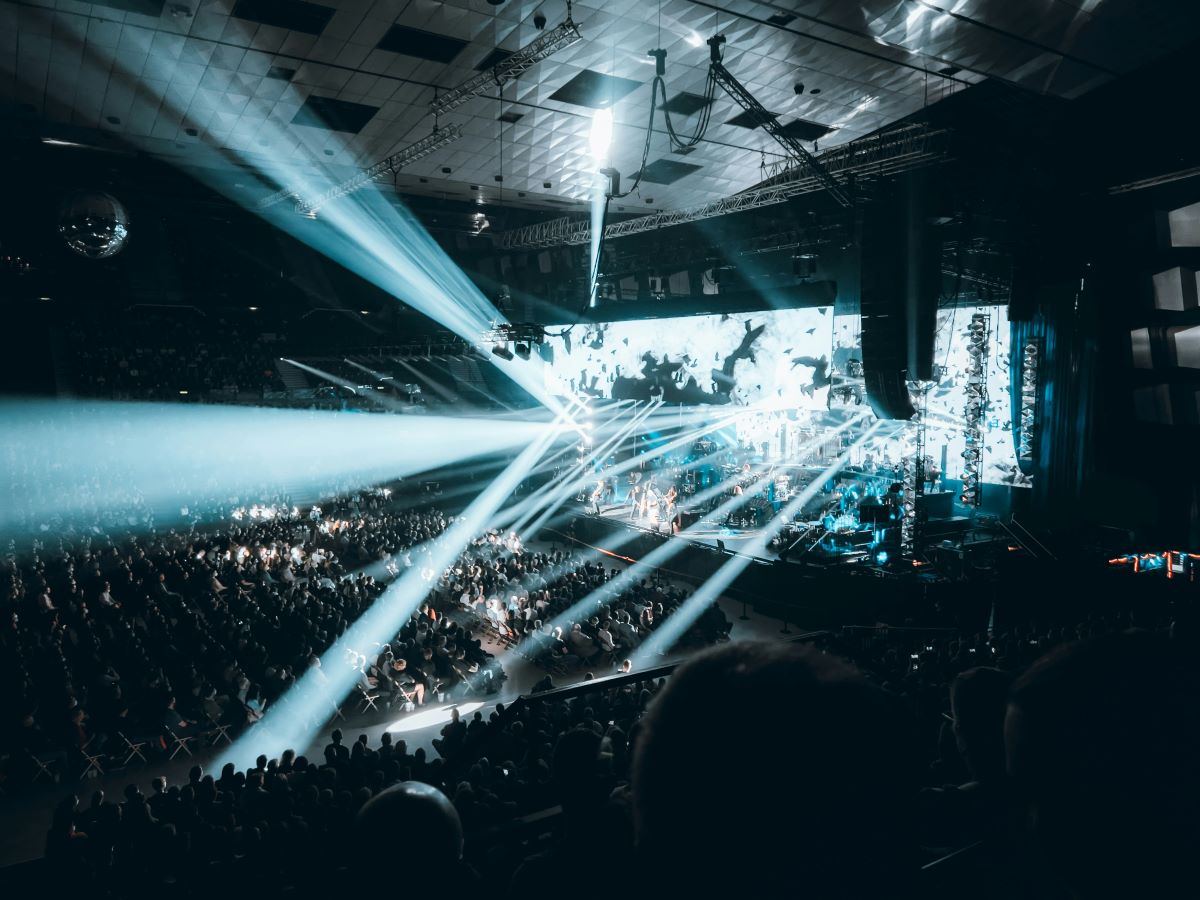Die Kraft immersiver Visuals in Live-Musik
In modernen Konzerten, Das Publikum erwartet mehr als Klang. Sie sehnen sich nach Eintauchen. Die Kombination von Musik, Beleuchtung, Und LED-Bildschirme schafft unvergessliche Erlebnisse. Da Künstler eine tiefere Einbindung des Publikums anstreben, Die LED-Display-Technologie spielt mittlerweile eine zentrale Rolle bei der Gestaltung des Bühnenbildes, Geschichtenerzählen, und Markenidentität.
1. Warum LED-Bildschirme bei Konzertinnovationen führend sind
LED-Bildschirme sind aus der modernen Bühnenkunst nicht mehr wegzudenken. Im Vergleich zur herkömmlichen Projektion, LED-Anzeigen bieten einen schärferen Kontrast, nahtlose Skalierbarkeit, und Echtzeit-Reaktionsfähigkeit. Ihre lebendigen Farben und programmierbaren Grafiken ermöglichen es Designern, Musik mit atemberaubenden Grafiken zu synchronisieren.
Zusätzlich, Modulare LED-Panels können an verschiedene Bühnenformen und Veranstaltungsorte angepasst werden. Ob für Stadien oder Indoor-Theater, LED-Bildschirme sorgen auch bei hellem Bühnenlicht für eine gute Sichtbarkeit. Diese Zuverlässigkeit, gepaart mit Flexibilität, macht sie zur ersten Wahl für Konzertumgebungen.
2. Die Psychologie des Eintauchens in Live-Events
Immersive Erlebnisse fesseln die Aufmerksamkeit, Ablenkungen reduzieren, und stärkere emotionale Reaktionen hervorrufen. Wenn Visuals einen Künstler umhüllen oder mit dem Takt pulsieren, Das Publikum fühlt sich verbundener. Diese multisensorischen Interaktionen werden durch die Integration von Raumklang erreicht, synchronisierte Bilder, und dynamische Beleuchtung – alles konzentriert auf LED-Hintergründe.
Darüber hinaus, mit gebogenen oder umlaufenden LED-Formaten, Designer können virtuelle Umgebungen erstellen, die in Echtzeit reagieren. Infolge, Das Publikum fühlt sich entführt – sei es in einen digitalen Dschungel, eine futuristische Skyline, oder ein kosmisches Reich.
Daher, Der LED-Bildschirm ist nicht nur Dekoration – er ist ein Tor zum Eintauchen.
3. Designelemente, die immersive Konzerte prägen
Um wirkungsvolle visuelle Hintergründe zu schaffen, Es müssen mehrere Gestaltungsprinzipien angewendet werden:
A. Pixeldichte und Auflösung
Eine höhere Pixeldichte ermöglicht schärfere Bilder, vor allem, wenn das Publikum nah an der Bühne ist. Für eindrucksvolle Bilder, Häufig werden Panels mit einem Pixelabstand unter 2,5 mm verwendet. Diese ermöglichen Details auf 4K-Niveau auf mittelgroßen Bühnenwänden.
B. Gebogene und flexible Formate
Flexible LED-Panels können sich um Ecken biegen oder ganze Bühnenstrukturen umhüllen. Dies erhöht die Tiefe und Dimensionalität, insbesondere bei der Verwendung von 3D- oder Motion-Tracking-Visuals.
C. Inhaltszuordnung und Echtzeitsynchronisierung
Moderne Konzerte nutzen Medienserver, um Video-Loops in Echtzeit mit Musik abzugleichen. Das LED-Display empfängt Hinweise, um die visuelle Darstellung synchron mit Instrumenten oder Choreografie zu ändern. Diese Technik verbessert das Eintauchen durch rhythmusangepasste Bilder.
4. Praxisbeispiele: Künstler und visuelle Architekten bei der Arbeit
Große Acts wie Beyoncé, Coldplay, und Travis Scott setzen stark auf LED-Installationen. Ihre Konzerttouren zeigen immersive LED-Architektur mit animierten Landschaften, bewegungsreaktive Hintergründe, und umlaufende Wände auf der gesamten Bühne.
Zum Beispiel, Coldplays 2023 Die Tour nutzte LED-Böden und vertikale Türme, um das Publikum in bewegte Galaxien einzuhüllen. Dies war nur mit Ultraleicht möglich, modulare LED-Panels.
Ebenfalls, Produktionsfirmen bieten mittlerweile Full-Service-Pakete an: Von der Vermietung von LED-Bildschirmen bis hin zur Kalibrierung vor Ort und der Integration von Inhalten. Dieses Ökosystem ermöglicht es kleinen Künstlern, großformatige Visuals zu geringeren Kosten zu übernehmen.
5. Verbessern Sie die Audience Journey mit LED-Visuals
Mehr als atemberaubende Grafiken, Immersive LED-Bildschirme leiten auch das Publikumserlebnis. Zum Beispiel:
- Übergangsszenen: LED-Bildschirme überbrücken Szenenwechsel mit Animationen oder filmischen Übergängen.
- Beteiligung des Publikums: Einige LED-Systeme interagieren mit mobilen Apps oder Live-Feeds, So können die Fans sich selbst auf der Bühne sehen.
- Markenbotschaften: LED-Hintergründe liefern Werbevisualisierungen, Sponsorenlogos, oder narrativen Kontext – alles ohne die Immersion zu unterbrechen.
Daher, LED-Bildschirme werden zu aktiven Werkzeugen zum Geschichtenerzählen, nicht nur Dekoration.
6. Technische Vorteile von LED-Überprojektionssystemen
LED-Bildschirme übertreffen Projektionssysteme in mehrfacher Hinsicht:
- Helligkeit: LED-Panels sorgen auch bei Tageslicht oder intensiver Bühnenbeleuchtung für gute Sichtbarkeit.
- Nahtlosigkeit: Modulare Paneele bieten große Vorteile, rahmenlose Grafik, im Gegensatz zu Projektormischungen.
- Latenz: LED-Systeme ermöglichen eine Videowiedergabe mit geringer Latenz, entscheidend für die Echtzeitsynchronisierung mit dem Ton.
- Haltbarkeit: LED-Module sind hitzebeständig, Feuchtigkeit, und besser zu transportieren als Projektionsgeräte.
Diese Eigenschaften erklären, warum LED-Bildschirme den modernen Konzertaufbau dominieren.
7. Anpassung, Skalierbarkeit, und Nachhaltigkeit
LED-Systeme lassen sich problemlos skalieren. Designer können 8-Meter-Wände oder kompakte 2-Meter-Wände bauen×2-Meter-Riser. Darüber hinaus, Wiederverwendbare LED-Panels senken langfristig die Produktionskosten. Der modulare Aufbau reduziert Abfall und verkürzt die Rüstzeit.
Zusätzlich, LEDs der neuen Generation verbrauchen weniger Strom pro Quadratmeter, Reduzierung des CO2-Fußabdrucks. Bei Integration in grün-zertifizierte Veranstaltungsorte, Sie unterstützen Nachhaltigkeitsziele und verbessern gleichzeitig die Ästhetik.
Dieser doppelte Wert – ökologisch und wirtschaftlich – treibt den Einsatz von LEDs bei immersiven Konzerten weiter voran.
8. Die Zukunft: Holographische Integration und darüber hinaus
Blick nach vorn, Die Grenze zwischen Bildschirm und Bühne verschwimmt. Unternehmen testen transparente LED-Panels, holographische Schichten, und Augmented-Reality-Integration.
In einigen Piloten, 3D-Hologramme treten neben Live-Sängern auf, mit LED-Hintergründen, die als Beleuchtungsmatrizen und Tiefenhinweise fungieren. Diese Technologien versprechen ein noch tieferes Eintauchen, angetrieben durch schnellere Chips und feinere Pixelsteuerungen.
In allen Szenarien, LED bleibt das Rückgrat – flexibel, programmierbar, und hochwirksam.
Abschluss: Den Weg zum ultimativen Konzerterlebnis ebnen
Zusammenfassend, Die LED-Anzeigebildschirm hat neu definiert, was ein Konzert sein kann. Es wandelt Klang in Sicht um, Darsteller zu visuellen Geschichtenerzählern, und Publikum in versunkene Teilnehmer verwandeln.
Von flexiblen Modulen und pixelgenauer Klarheit bis hin zu Echtzeit-Motion-Visuals, LED-Hintergründe sind heute von zentraler Bedeutung für die immersive Konzertgestaltung. Für Marken, Künstler, Und die Investition in diese Technologie ist nicht mehr optional – sie ist unerlässlich.
Als 2025 weckt neue Erwartungen an Live-Shows, Wer immersive Visuals beherrscht, wird die nächste Ära der Bühneninnovation anführen.




